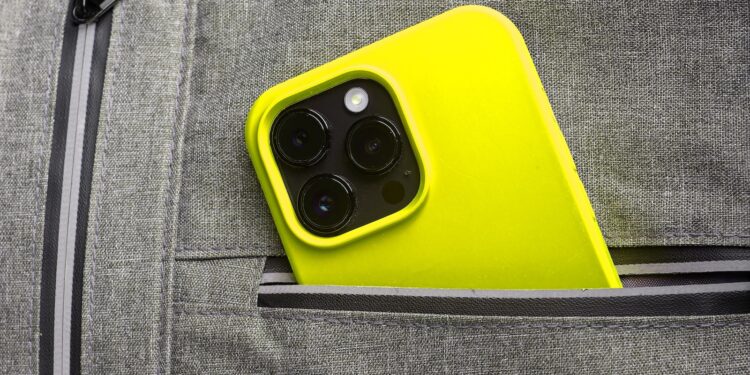If you take photos with your iPhone and value maximum image quality, you should work in RAW format. RAW files offer significantly more image information than JPEGs. This is especially noticeable when editing: You can adjust exposure, colors, contrast, and details much more precisely. In this article, you'll find eight simple yet effective tips for properly editing iPhone RAW photos—no unnecessary theory, directly applicable, and suitable for every skill level.
The RAW format used to be reserved for SLR cameras and professionals. Today, your iPhone can also take RAW photos – provided you're using an iPhone 12 Pro or later. Apple's ProRAW feature combines the flexibility of RAW with the processing power of the iPhone. If you also rely on third-party apps, you get even more control over your images. RAW images aren't automatically better. The difference comes down to editing. JPEGs already have a lot of image information baked into them, while RAW gives you more flexibility. This means more responsibility – but also more creative freedom. Here are the eight most important steps to fully utilize the potential of iPhone RAW photos.
Enable RAW recording
For your iPhone to save RAW photos, you must first enable the feature. To do this, go to Settings > Camera > Formats. There you can enable "Apple ProRAW." On newer devices like the iPhone 14 Pro or iPhone 15 Pro, you can also choose whether you want to shoot in JPEG, HEIF, or directly in RAW+JPEG. RAW files are large—each photo can take up around 25 MB or more. If you regularly shoot in RAW, you should make sure you have enough internal storage or, alternatively, use iCloud or external storage options.
Use third-party RAW apps
While the iPhone's native camera app can capture RAW photos, it's worth looking into specialized apps for more control. Two highly recommended options are Halide and Adobe Lightroom Mobile.
- Halide offers manual control over exposure, focus, ISO, and white balance. The app displays focus peaking, a histogram, and allows you to save RAW files directly in DNG format.
- Adobe Lightroom Mobile also offers a complete development workflow. You can import photos directly, edit them, and even save them to the cloud. A particularly useful feature is the ability to synchronize your mobile workflow with your desktop Lightroom.
Adjust exposure and contrast
In RAW editing, you should specifically adjust highlights and shadows. Instead of focusing on brightness alone, use tools like tone curves or levels. These allow you to darken highlights, emphasize midtones, and brighten shadows without losing detail. A common mistake is increasing the contrast too much. Make sure that no areas are completely burned out or drowned—that is, become completely white or black. RAW gives you the freedom to bring back details, but this only works if you didn't completely lose them during the photoshoot.
Set white balance manually
While automatic white balance is convenient, it's not always accurate—especially in mixed light or at dusk. In RAW processing, you can adjust color temperature and tint afterward without any loss of quality. This is especially important for portraits or shots with a lot of skin tones. A slight color cast can otherwise quickly appear unnatural. Be careful here and use reference values or gray cards if you often shoot indoors.
Fine-tune color space and saturation
RAW files work with extended color spaces. Adobe RGB or ProPhoto RGB offer more nuances than sRGB, the standard format for web and social media. The larger color space is worthwhile for editing—even if you have to convert to sRGB later for export. When it comes to saturation, less is often more. A gentle increase makes the image more vibrant without appearing kitschy. If necessary, use selective color correction to specifically influence individual colors—such as the sky, skin, or plants.
Bring out sharpness and details
One advantage of RAW photos is that they are saved without in-camera sharpening. This allows you to adjust the sharpness in post-processing. Use tools like Clarity, Structure, or Detail Sharpness to emphasize textures. Be careful not to overdo it. Too much sharpening leads to halos or unnatural edges. Values between 10 and 20 percent are usually sufficient. The optimal sharpening depends heavily on the subject and the output size.
Use noise reduction specifically
RAW images show more noise, especially in low light or at high ISO values. This gives you complete control during editing. Most apps offer two-stage noise reduction: luminance noise (brightness) and color noise (color points). Reduce luminance noise carefully so the image doesn't become too soft. Color noise can usually be smoothed more effectively without being noticeable. It's best to check the result in 100% resolution.
Export and final editing on the Mac
Once your RAW image is ready, you can export it for further processing. Formats like TIFF (lossless) or high-resolution JPEG (if you want to save storage space) are ideal. If you want to get more out of it, continue editing your photo on your Mac. Programs like Capture One or Photoshop offer tools for retouching, color correction, or output for print and the web. The larger display and more precise control are especially beneficial for finer work and professional results.
With these tips, your iPhone will become a professional camera
Editing iPhone RAW photos is easier than it sounds – if you know the right steps. The combination of high-quality cameras, ProRAW support, and powerful apps makes the iPhone a true tool for creative photo editing. With these eight tips, you can precisely control exposure, colors, sharpness, and noise, creating images that go far beyond the standard. Give it a try, refine your workflow, and regain full control over your iPhone photos. The best products for you: Our Amazon storefront offers a wide selection of accessories, including those for HomeKit. (Image: Shutterstock / valiantsin suprunovich)
- iPhone & Co.: How to deactivate the advanced visual search
- Extend iPhone battery life: These 7 tips help immediately
- Apple Music in iOS 26: Music Pins make access easier
- Setting up iPhone widgets: These 6 tricks you need to know
- Set up Apple Pay on your iPhone – quickly and securely
- Why an iPhone? These advantages are convincing in the long term
- Secure your iPhone properly: 5 important functions at a glance
- Save iPhone battery: When is power saving mode worth it?
- Use Apple Wallet safely, conveniently, and efficiently – 7 tips
- LG or Samsung Smart TV? How to disable tracking
FAQ – Editing iPhone RAW photos
RAW files store all of your iPhone's sensor data unprocessed, while JPEG or HEIF files are already compressed and color-adjusted. This means you have significantly more flexibility when editing RAW images to fine-tune exposure, color, and contrast, and to recover details lost in compressed formats.
Apple ProRAW is available starting with the iPhone 12 Pro and 12 Pro Max. Each subsequent Pro model, including the iPhone 13 Pro, 14 Pro, 15 Pro, and 16 Pro, also offers this feature.
Open the Settings app, select "Camera," then "Formats." There, enable "Apple ProRAW." A small RAW icon will then appear in the top right corner of the Camera app, allowing you to turn the format on or off as needed.
While you can generally shoot RAW directly with the built-in camera app, apps like Halide or Adobe Lightroom Mobile offer more manual control. Halide, for example, shows you focus peaking and a histogram, while Lightroom Mobile integrates a complete editing and cloud workflow that you can seamlessly sync with the desktop version.
A single ProRAW image typically takes up about 25 MB or more. If you frequently shoot in RAW, you should ensure you have sufficient internal storage or, alternatively, use iCloud storage or external drives.
In a RAW workflow, you often start with Curves or Levels to precisely adjust highlights, midtones, and shadows. Then, you manually set the white balance to avoid color casts. Use a wide color space like Adobe RGB or ProPhoto RGB for color management and only convert to sRGB for web photos when exporting. You can add sharpness using Clarity or Detail Sharpness, and adjust noise separately for luminance and color to achieve optimal results.
Lightroom Mobile is ideal for quick adjustments on the go, combining cloud sync and mobile tools. For sophisticated retouching, color correction, or print preparation, the large screen and precise control of programs like Capture One or Photoshop on the Mac are unbeatable.
If you want to create a lossless master archive, TIFF is ideal. For space-saving final exports, such as for social media, a high-resolution JPEG is sufficient. Always ensure you use the correct color profile when exporting: sRGB for online display, Adobe RGB or CMYK for print output.
Raw files aren't supported by social media apps. Therefore, you'll need to export to JPEG or PNG before uploading, choosing the desired resolution and color profile.
RAW is especially worthwhile if you take deliberate photos and want maximum flexibility in image composition later. For spontaneous snapshots where speed and storage are important, the JPEG format, which already includes in-camera optimizations, is often sufficient.





